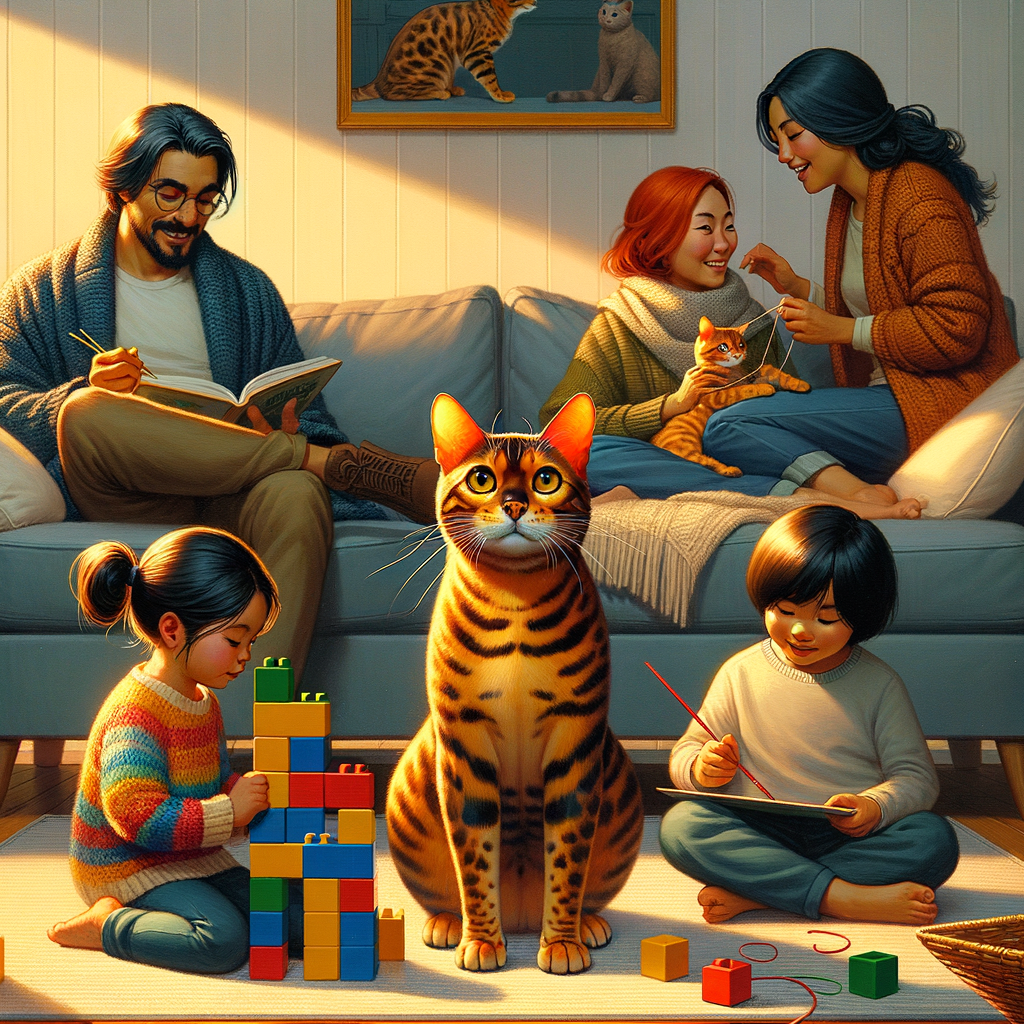
Introduction to Bengal Cats
-
- Origin and history of Bengal cats
Bengal cats are a unique breed that originated from a cross between domestic cats and the Asian leopard cat. This breed was first developed in the 1970s by a breeder named Jean Mill. She wanted to create a cat that looked like a wild leopard but had the temperament of a domestic cat. The Bengal cat was officially recognized as a breed by The International Cat Association (TICA) in 1983.
-
- Physical characteristics of Bengal cats
Bengal cats are known for their striking appearance. They have a sleek, muscular body and a beautiful coat that comes in various colors and patterns. The most common pattern is the spotted or marbled coat, which resembles that of a wild leopard. Their fur is short and dense, making it soft to the touch. Bengal cats also have large, expressive eyes that can be green, gold, or blue.
Bengal Cat Behavior
-
- General Bengal cat behavior
Bengal cats are known for their playful and energetic nature. They love to climb, jump, and explore their surroundings. These cats are very curious and intelligent, often figuring out how to open doors or cabinets. Bengals are also very vocal and will often “talk” to their owners with a variety of meows and chirps.
-
- Unique traits of Bengal cat behavior
One unique trait of Bengal cats is their love for water. Unlike many other cat breeds, Bengals enjoy playing with water and may even join you in the shower or bath. They also have a strong hunting instinct and will often engage in stalking and pouncing games. Bengals are very social and form strong bonds with their owners, often following them around the house.
Bengal Cat Social Traits
Interaction with Humans
-
Bengal Cat Human Bonding
Bengal cats are known for forming strong bonds with their human companions. They are social animals that enjoy spending time with their owners. These cats often follow their humans around the house, showing a keen interest in their activities.
Studies have shown that Bengal cats can recognize their owner’s voice and respond to it. This bond is strengthened through regular interaction and play. For example, a Bengal cat might bring a toy to its owner, inviting them to join in the fun.
-
How Bengal Cats Show Affection to Humans
Bengal cats have unique ways of showing affection. They may rub against their owner’s legs, purr loudly, or even give gentle headbutts. These actions are signs of love and trust.
Another way Bengal cats show affection is by kneading with their paws. This behavior, often accompanied by purring, is a sign of contentment and comfort. Some Bengal cats also enjoy sitting on their owner’s lap or sleeping close by, seeking warmth and companionship.
Interaction with Other Pets
-
Bengal Cat Interaction with Other Cats
- Start with separate spaces for each cat.
- Let them sniff each other’s belongings.
- Supervise their first few meetings.
- Give them time to adjust.
-
Bengal Cat Interaction with Dogs
- Keep the dog on a leash during the first meeting.
- Allow the cat to approach the dog at its own pace.
- Use positive reinforcement for both pets.
- Monitor their interactions closely.
Bengal Cat Personality
-
- Key aspects of Bengal cat personality:
Bengal cats are known for their playful and energetic nature. They love to explore and can be very curious. These cats are also very intelligent and can learn tricks easily. Bengals are often described as having a dog-like personality because they enjoy fetching and playing in water.
-
- How Bengal cat personality differs from other breeds:
Unlike many other cat breeds, Bengal cats are very active and require a lot of mental and physical stimulation. They are more social and enjoy spending time with their human companions. While some cats may be content to lounge around all day, Bengals need activities to keep them entertained.
Social Habits of Bengal Cats
Indoor Social Habits
- How Bengal cats behave at home: Bengal cats are known for their playful and energetic nature. At home, they love to explore every corner and often engage in activities like climbing and jumping. They are very curious and enjoy interactive toys that challenge their intelligence. Bengals are also known to be quite vocal, often communicating with their owners through a variety of sounds.
- How Bengal cats interact with family members: Bengal cats form strong bonds with their family members. They are very affectionate and enjoy spending time with people. They often follow their owners around the house and may even try to join in on activities. Bengals are also known to be good with children, as they are patient and enjoy playing. They can get along well with other pets too, provided they are properly introduced.
Outdoor Social Habits
- How Bengal cats behave outsideBengal cats are very active and curious when they are outdoors. They love to explore their surroundings. These cats often climb trees and chase after small animals like birds and insects. Their wild ancestry makes them excellent hunters. Keep an eye on them to ensure they stay safe.
According to a study, Bengal cats can cover a lot of ground in a short time. They can run up to 35 miles per hour. This speed helps them catch prey and escape from danger quickly.
- How Bengal cats interact with strangersBengal cats are generally friendly but can be cautious around strangers. They may observe new people from a distance before deciding to approach. Once they feel safe, they can be very social and enjoy being petted.
Many Bengal cat owners report that their cats warm up to strangers after a few minutes. They may even start to play with them. However, it is always a good idea to let the cat make the first move.
Bengal Cat Companionship
Why Bengal Cats Make Good Companions
- Affectionate: Bengal cats enjoy cuddling and being close to their owners.
- Intelligent: They are smart and can learn tricks, making playtime fun and engaging.
- Active: Bengal cats have high energy levels and love to play, which can keep you entertained.
- Curious: Their curiosity keeps them exploring and discovering new things, adding excitement to your home.
Stories of Bengal Cat Companionship
- Max and Lily: Max, a Bengal cat, helped his owner Lily through a tough time by always being by her side. His playful antics and loving nature brought joy to her life.
- Tom and Jerry: Tom, a Bengal cat, and Jerry, a dog, became best friends. They played together and even slept next to each other, showing that Bengal cats can get along well with other pets.
- Sophia and Bella: Sophia, a young girl, found a best friend in her Bengal cat, Bella. Bella’s playful and affectionate nature made her the perfect companion for Sophia.
Bengal Cat Socialization
Socialization Techniques
-
- How to socialize a Bengal cat
Socializing a Bengal cat can be a fun and rewarding experience. Start by introducing your Bengal to new people and pets slowly. Use treats and toys to create positive associations. Spend time playing and cuddling to build trust.
-
- Challenges in Bengal cat socialization
There can be some challenges when socializing a Bengal cat. They are very active and curious, which can sometimes lead to mischief. They may also be wary of strangers at first. Consistent and gentle handling can help overcome these challenges. If needed, consult a vet or a cat behaviorist for advice.
Bengal Cat Temperament
-
- Bengal cat temperament
Bengal cats are known for their playful and energetic nature. They are very active and love to explore their surroundings. Unlike some other cat breeds, Bengals are very social and enjoy spending time with their human families. They are also quite vocal and will often communicate with you through meows and purrs.
One key aspect of their temperament is their intelligence. Bengal cats are very smart and can learn new tricks quickly. They enjoy interactive toys and games that challenge their minds. This intelligence also means they can get bored easily, keep them entertained.
-
- How to manage Bengal cat temperament
-
-
- Playtime: Spend at least 15-20 minutes a day playing with your Bengal cat. Use toys that mimic hunting, like feather wands or laser pointers.
- Environment: Create a stimulating environment with climbing trees, scratching posts, and puzzle feeders.
- Training: Teach your Bengal cat simple commands and tricks. This not only keeps them engaged but also strengthens your bond.
- Socialization: Introduce your Bengal cat to new people and pets gradually. This helps them become more comfortable in different situations.
-
The Friendly Nature of Bengal Cats
- Summary of Bengal cat friendliness: Bengal cats are known for their friendly and social nature. They enjoy interacting with their human families and often seek attention and playtime. Their affectionate behavior makes them great companions for both individuals and families.
- Final thoughts on Bengal cat social traits: Bengal cats are not just beautiful; they are also incredibly social and loving. Their playful and curious demeanor, combined with their need for companionship, makes them unique pets. If you are looking for a cat that will be an active part of your life, a Bengal cat might be the perfect choice.






